The reason why I decided to write about this topic is because I also want to learn photography. For me this topic would be very interesting since I’m a Broadcasting student. As far as I know, Photography is related to the course I’ve taken.
No place is boring, if you’ve had a good night’s sleep and have a pocket full of unexposed film. -Robert Adams
6 reasons why Photography matters:
1. Our photographs tells us what is important to us.
When you ask people what possessions they would rescue from their burning house, one of the most frequent answers is the photograph album or a computer with their digital images. When in panic mode it’s interesting that we would probably grab photos rather than valuable jewelry. This impulse to save our recorded memories is a powerful force which tells us much about the role of photography in our lives and our constant desire to distill our most precious moments into images.
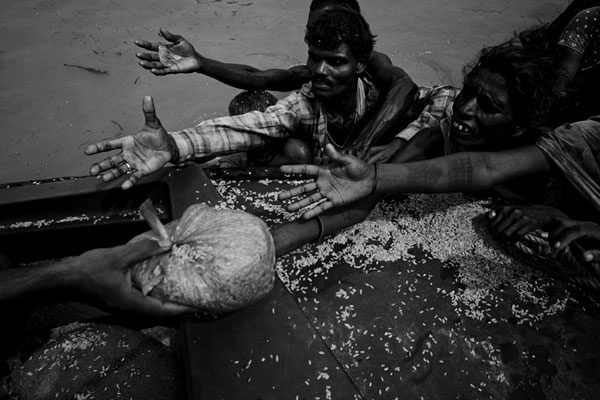
Photography preserves the important events and people in our lives. The ceremonies of birth and birthdays, marriages and anniversaries, holidays and new houses are all recorded because they matter. Photographs are our personal story, a timeline of our lives filled with faces and places that we love. They are our story, which we can share with others. The hundreds of images come together to form a narrative of our lives.
2. Photographs are part of our legacy.
A couple of generations later it might surface among old papers in an attic and someone would search for granddad among the fresh young faces. Photographs matter because they freeze moments of our lives which pass unremarkable and which seem to have little importance to us at the time. The significance, however, may be for others who search for the person we once were or the places we once knew. They can be small pieces of a jigsaw that complete the larger picture of our lives.
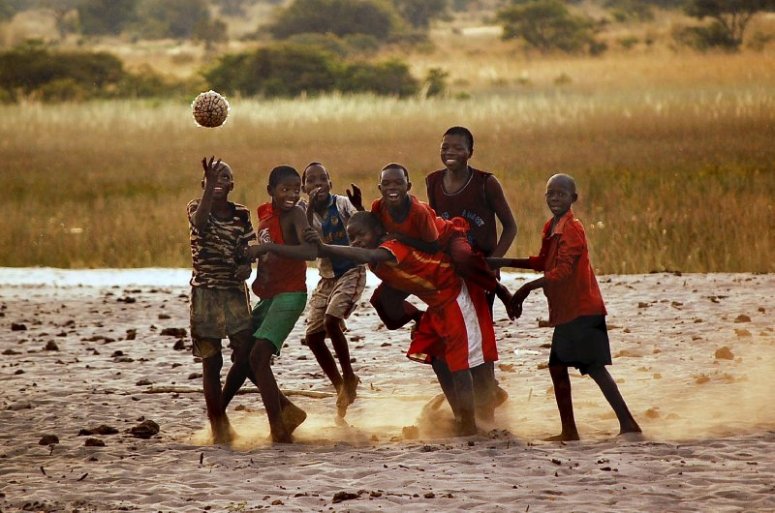
3. Photographs allow us to share and communicate.
Images are much more than a simple record. Photography speaks to the best and most generous part of our human nature – the desire to share what we find beautiful and interesting with others. You only have to look at Facebook, Instagram, Google and other social media sites that can share photos for us to see this impulse at work. Millions of people sharing their personal, passionate and sometimes quirky take on the world around them. Our images can involve a world of strangers in our life. How powerful is that?

4. Photography makes us an artist.
Photography allows us to express ourselves through an art form. We notice a beautiful landscape or an old man’s lined face and we want to capture it. Each of us will have a different reason to do so but, essentially, we want to create something. However humdrum our nine-to-five lives may be, the creation of an image makes us an artist. It feels good.
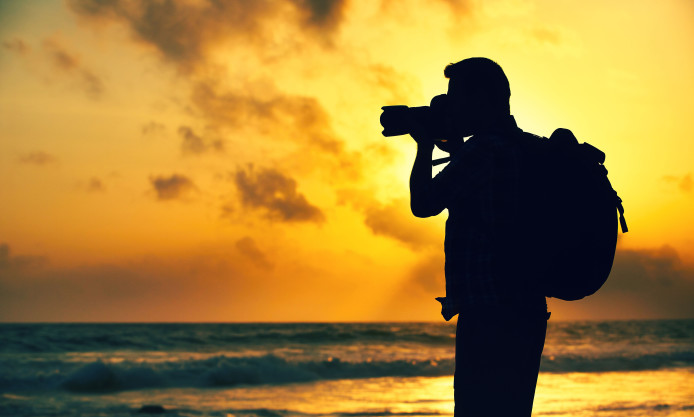
5. Photography is a complex language.
Photos can express emotions such as joy, sorrow, wonder and sympathy. Every person’s emotion can find a place in photography. Why? Because photography gives you the ability to express your thoughts or your emotions. If you cannot express your thoughts in verbally, well photography is one of the best way to express your feelings or your thoughts that you cannot put into words.

6. Photographs has the power to move us.
Photographs can grab our attention and speak directly to our emotions. At a more subtle level, we can learn lessons about a whole range of emotions. Grief has the power to wash away the luminance and chrominance of our lives. There is no magic way to restore them at will. We have to be patient. But while waiting we can search for the shapes and patterns that are still there in the grayness. They will lead us back to color eventually. At moments of great sorrows in our life we have used images to express that hope of returning the colors in our life.
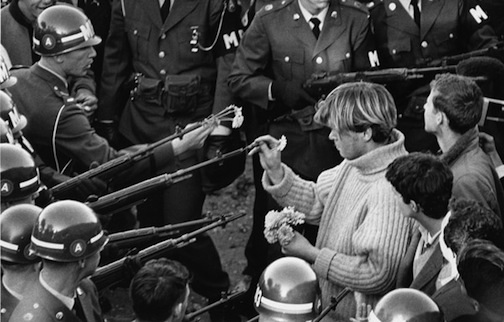
Photography, at its best, is a powerful language which speaks to our emotions. It allows us to tell our story and show others our framing of the world around us.
Trivia’s about photography:
30 interesting facts about photography
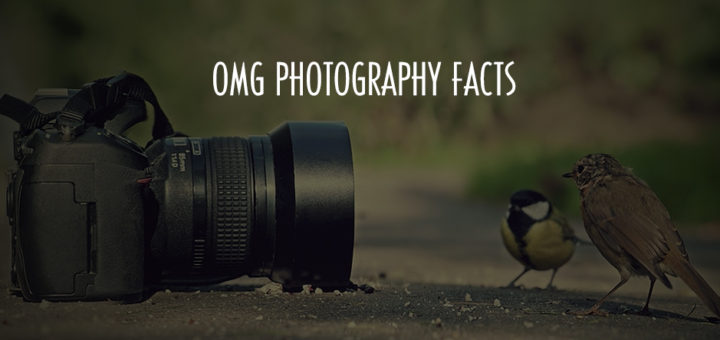
1. The ‘Kodak Moment’ – you must remember the commercial, don’t you? Popularly known as Kodak, the Eastman Kodak Company that was founded in 1888 by George Eastman and by 1976, the company captured 90% of market share in terms of sales of photographic films in US. [Wikipedia]
2. Kodak was really slow to make a transition into digital photography and by late 90s, even the sale of photographic films dropped so significantly that Kodak almost became bankrupt. In 2012 (January), the company filed for bankruptcy protection as per Chapter 11 of US bankruptcy law and was forced to sell several of its patents at a price of $525 million to companies like HTC, Adobe Systems, Samsung, Microsoft, Amazon, Facebook, Google and Apple by 2013. This helped the company to emerge from bankruptcy on September 4, 2013. [Wikipedia]
3. It is very ironical that the core technology used in digital photography today was actually invented by Kodak. [Wikipedia]
4. Travelling back in time, photography wasn’t as simple as ‘smile and click’ as we see today. Back in 1820s, early cameras would take several hours to actually capture a film! Technology is great, isn’t it?
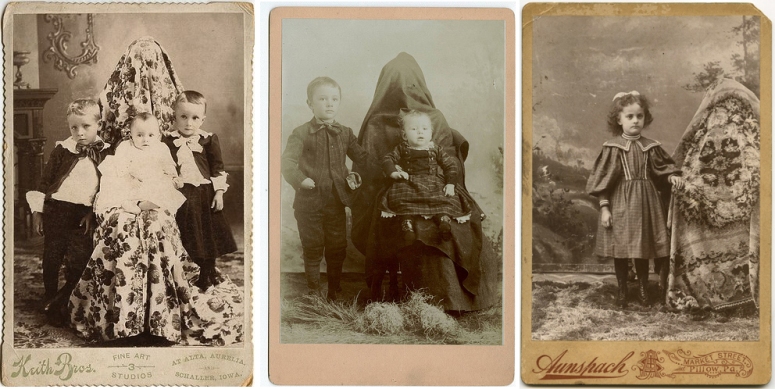
6. Photographing adult people was still okay but when it came to photographing children, things turned even more difficult. Most of the times mothers had to sit all covered and disguised as chair holding their babies. [Ridiculously Interesting]
7. Because of this enormously herculean task of photographing babies/children, a very eerie way was adopted for photographing children (though not always). And, what was that? Children were photographed after they died! That way, children would stay still for as long as required. This isn’t something that can be appreciated but it is definitely jaw-dropping. [Ridiculously Interesting]
8. In 1940s Rapatronic Photographic technique was developed by Dr. Harold Edgerton. The technique was used for capturing the growth of fireball of early nuclear explosion and the cameras had exposure time of 10 nanoseconds. Multiple cameras (4 to 10) were set with each rapatronic camera taking just one photograph at different intervals to capture the growth of fireball.
9. Today, the number of photographs clicked every two minutes is same as the number of photographs clicked by mankind in 1800s. [Buzzfeed]
10. The first every digital camera to be created was in December 1975. It was developed by an engineer in Kodak Company and took 23 seconds to create first photograph. The camera only recorded black and white photographs of 0.1 mega pixels. The camera weighed 8 pounds. [blog.tumbhi.com]
11. The total number of photographs present on Facebook is 10,000 times greater than the total number of photographs that can be found US Library of Congress. Photographs in US Library of Congress is a documentation of US history since its very beginning.
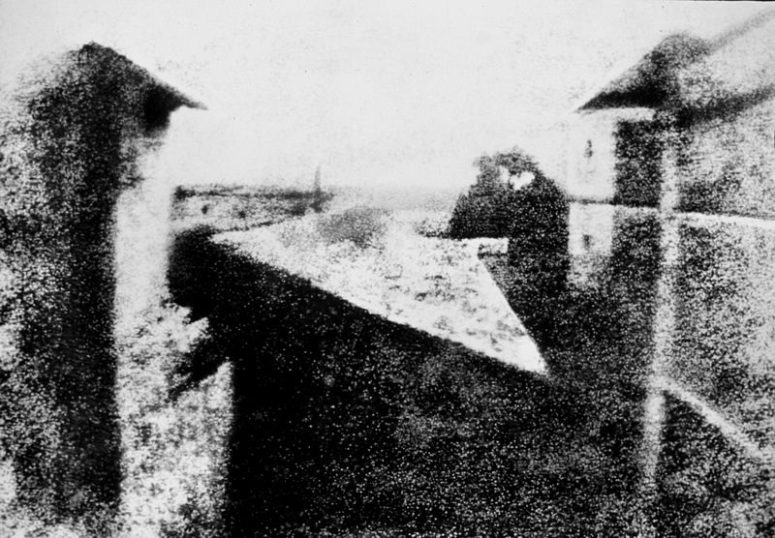
12. In 1826 a French photographer by the name Nicéphore Niépce clicked a photograph popular by the name ‘View From The Window At Le Gras’. He clicked the photograph from the window of his estate. Guess what? The exposure time for the photograph was ONLY 8 hours! [Huffington Post]
13. The first ever color photograph was shot in 1861 by a Scott physicist by the name of James Clark Maxwell. He used yellow, blue and red filters separately to photograph a tartan ribbon and then combined the three images to create the final color photograph. [National Geographic]
14. Austria’s Joseph Puchberger was the person to hold the first patent of panoramic camera. The patent application was submitted in 1843. The application was for a hand-cranked camera of 8-inch focal length and 150⁰ field view. [Wikipedia]
15. A 4MP digital camera was once the talk of the town but soon went into oblivion with manufacturers of likes of Canon and Nikon coming out with cameras of 22+ MP. You think that’s pretty awesome right? Here’s a bummer for you! Get yourself the Mamiya 645DF and amaze yourself with an amazing 80MP! It comes with a very small price tag of $37,995.00 only! Dare to buy?
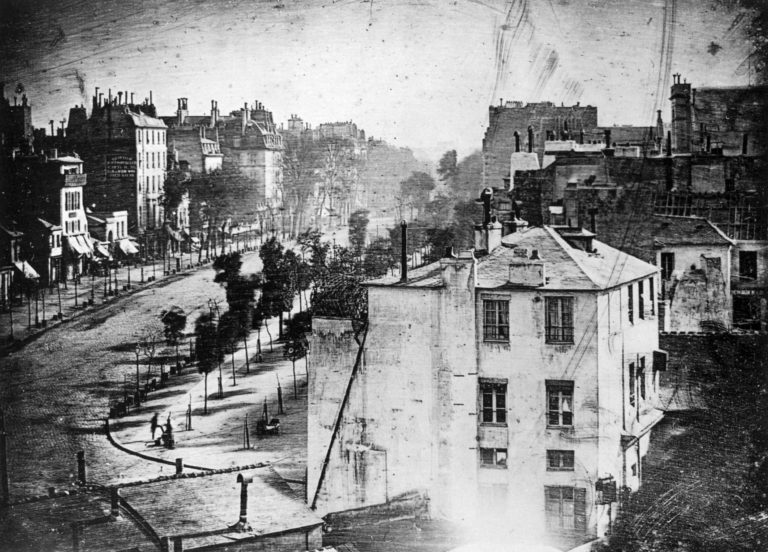
16. The oldest known photograph to have a person (human) in the shot was clicked in Paris in 1838. The man was actually getting his shoe polished! [Buzzfeed]
17. Talking of numbers, take a look at the timeline image below and be fascinated:
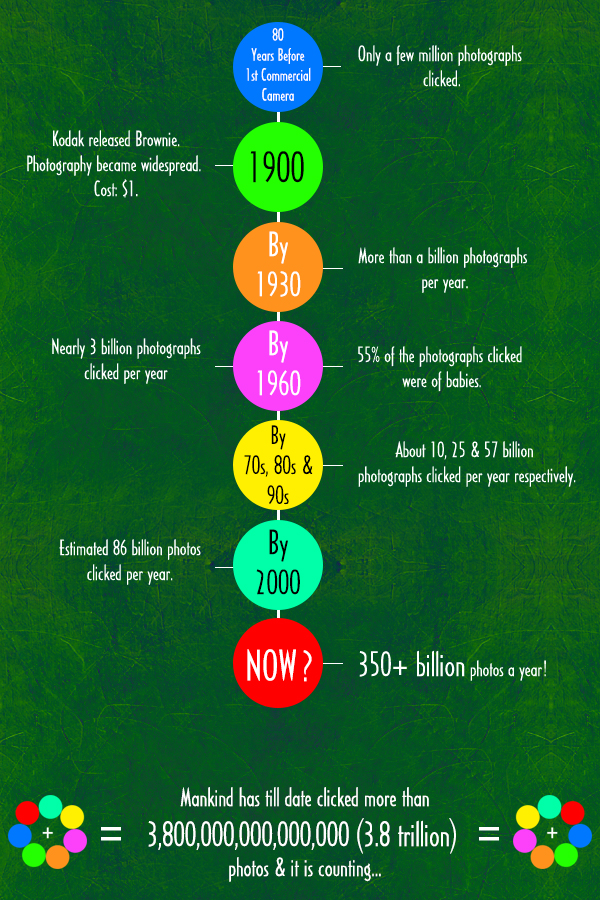
18. A photography competition was held in 2011 by the name Wiki Loves Monuments. Verenignig Wikimedia Nederland of Netherlands was one of the entrants who submitted 168,208 images in the competition. The images were clicked from July 1, 2011 to September 31, 2011. No doubt, they hold the world record of submitting the maximum numbers of photographs in a competition. [Guinness Book of World Records]
19. Wake Forest University’s James Schirillo and Kelsey Blackburn conducted a study in which they concluded that left side of a human face produces a more pleasant photograph compared to the right side of the face! They concluded that this happens possibly because left side has more emotional intensity compared to right side! [Science Daily]
20. What is the single most effective photo type for any women? It is the MySpace shot. To take a MySpace picture, the camera needs to be placed above the head at a specific angle. This however is not true for men. Photographs of men become more effective when they don’t smile and look away from the camera. [OkCupid]
21. The most expensive camera to be ever sold is 1923 Leica O-Series camera. This very rare specimen was put on auction in Vienna during a weekend and it was sold for $2.8 million or € 2.16 million! [Reuters]
22. Mumbai, India – based Dilish Parekh holds the world record of collecting the maximum number of antique cameras. Since 1977, this man collected 4,425 antique cameras with the oldest one in his collection being one from 1906. [Guinness Book of World Records]
23. There are more than 240 billion photos that have been uploaded on Facebook. As on August 2013, 350 million photographs were uploaded on Facebook every single day!
24. Ever heard of a whole building being used as a huge camera? The runways and control tower of California’s U.S. Marine Corps Air Station El Toro is the largest photograph to exist. It was photographed with a single exposure on a sanitized fabric. The whole building was used as a camera. The photograph was a part of the Legacy Project and is referred to as the Great Picture. It is 111 feet wide and 32 feet high! [Wikipedia]
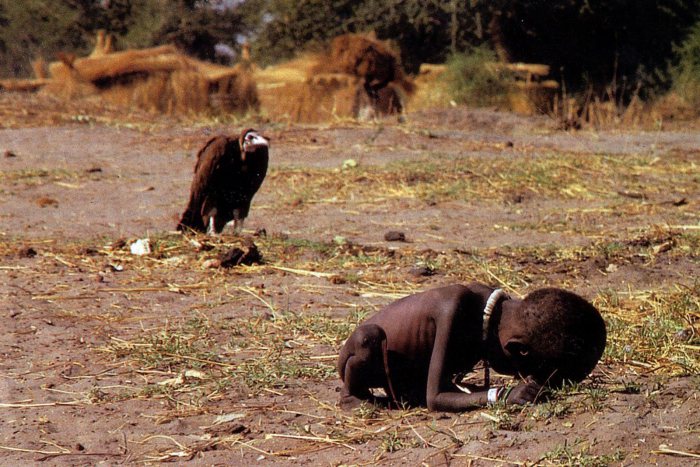
25. The saddest photograph considered till date is that of a vulture stalking on child in Sudan. It was clicked by photojournalist Kevin Carter from Johannesburg, South Africa. The photograph depicted Sudan’s 1994 famine. Carter received Pulitzer Prize for the photograph. However, he was so disturbed by all the sad stories he captured in his camera that he committed suicide at the age of 33. His suicide note stated: “I’m really, really sorry. The pain of life overrides the joy to the point that joy does not exist… depressed … without phone … money for rent … money for child support … money for debts … money!!! … I am haunted by the vivid memories of killings and corpses and anger and pain … of starving or wounded children, of trigger-happy madmen, often police, of killer executioners … I have gone to join Ken if I am that lucky.” [Wikipedia]
26. Lumière Brothers were the first to introduce viable color process in the world of photography. In 1907 they developed the first Autochrome plate.
27. The credit for first ever aerial photograph goes to Gaspar Felix Tournachon – a French photographer. He was a balloonist and took his first aerial photograph from a hot air balloon. [Wikipedia]
28. George Eastman – the founder of Kodak committed suicide at the age of 77 in year 1932. He brought photography to the masses and was suffering with spine disorder. In his suicide note he wrote: “My work is done – Why wait?” [Wikipedia]
29. Moon’s surface is a cold graveyard for 12 Hasselbald cameras. They were taken to moon during first landing of man on moon. However, in order to carry back lunar rock samples, those cameras were left there to compensate for the additional weight. [Wikipedia]
30. The first photographic image made with camera obscura was by Joseph Nicéphore Niépc in 1827. Prior to that, camera obscura was used only for drawing or viewing.
